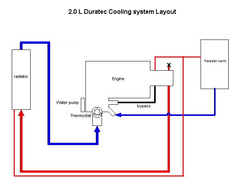

Description [/img]

Hi everyone, in my duratec MGB GT I did a trackday on Monday and was very pleased with the car apart from one thing. The coolant temperature dropped
dramatically when I went into high revs. It was going as low as 50 degrees! Ive been driving the car for a year and it heats up fine to high 90s, fan
cools it etc so no normal running issues, just major cooling when revved. Could it be bad plumbing?
Im running standard bypass hose, ST150 thermo with big inlet from rad, smaller inlet going to header tank, rear outlet to top of rad and a bleed from
rad to header.
Any ideas? It does it for the full 20 minute sessions that I was on.
Thanks
What fan do you have on the rad, if it has a viscous fan on the engine has that locked up and is now providing massive amounts of cooling at high revs? seems unlikely though
thermostat regulates water temperature so that is where I would look first. Also check the plumbing as it may be that water is able to bypass the stat allowing overcooling.
[img]


Description
[/img]
I agree thermostat first place to look
I would tape part of the rad to see if temp stabalises
A last thought is voltage, is alternator over driving and altering resistance across sender
If, when you stop reving, it goes straight back to 90 deg then I would suspect a sender or gauge issue.
I would agree with temp sender or gauge issue.
Where is your temp sender and how quickly does the temperature drop when you rev?
I've have MS sender problems of this sort (temp in the datalogs jumps about a bit down to 50degC and disagrees with the gauge). If the temp
changes are all smooth then it is more likely to be plumbing.
My intention is to switch to a 2 lead sensor, but it hasn't worked its own way onto the car even though I left the instructions next to it.
Assuming your MG has an electrical temperature guage not a capillary type the problem is most likely to be voltage stabiliser which powers the
temperature gauge on a standard MG instrument panel.
It is located on the back of the dash often on back of the speedo or tacho.
However it could be a thermostat/by-pass problem the MGB used water valved controlled heater, Fords use an air blending heater.
To fit a modern Ford engine to an MG an additional by-pass connection is required between the hot side of the thermostat and the water pump inlet.
quote:
Originally posted by matt_gsxr
My intention is to switch to a 2 lead sensor, but it hasn't worked its own way onto the car even though I left the instructions next to it.
Hi everyone, thanks for the replies. I have it plumbed exactly as shown in the diagram above. I guess the thermostat could be closing too slowly, or the water pressure at high revs is holding it open maybe? Ill try some experiments tomorrow and let you all know how I get on. Thanks all.
Forgot to mention the interior gauge uses the standard mg capillary type and the ecu (emerald) uses the emerald sensor. Ill try it with laptop connected and check the ecu matches the gauge.
Capillary types either work or the don't so that leaves a water circulation issue go straight for the thermostat.
A thought occurred to me this morning,
I am not a 100% up to speed on modern Ford thermostats but looking at pictures of one is it possible the the thermostat is similar to the MG-Rover
PRRT type ie the thermostat is also designed to open under flow pressure --- make sense ??
PRRT thermostats open under coolant flow pressure ie at higher revs) to circulate coolant prevent local overheating if the engine is given a lot of
welly immediately after a cold start.
If this is the case it would suggest either the thermostat is faulty or the flow through by-pass hose is restricted.
[Edited on 6/12/13 by britishtrident]
Hi everyone, thanks for the responses. Today I took the car for a drive with the laptop connected to the ecu. When driven hard the gauge on the dash was well off of what the ecu was telling me. The ecu temp went down to 74 degrees. Is this still too low?
On most modern tintops the guage will show "N" as soon as the temp reaches 75c and stay planted on "N" until the temperature goes
above about 117c which is just below boiling point at radiator pressure. Over 117c the needle shoots up to the end of the scale and triggers a
warning light.
[Edited on 7/12/13 by britishtrident]